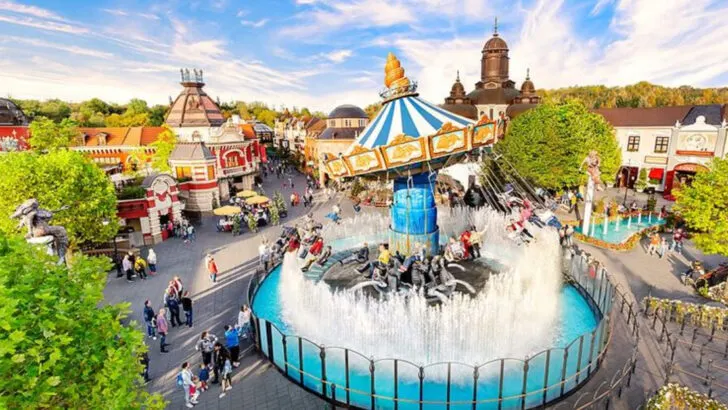Theme parks in America and Europe offer thrilling experiences, but they differ in several fascinating ways.
From scale to cultural nuances, these differences create unique adventures on each continent.
Scale and Size
In America, theme parks are sprawling giants. Walt Disney World, for example, spans a massive area with numerous themed lands and hotels. This vastness allows for grandiose attractions and extensive resort experiences.
In contrast, European parks like Tivoli Gardens in Copenhagen pack a punch in smaller spaces. These parks are often nestled near urban areas where land is limited, resulting in a more compact yet charming setup.
Visitors can expect an intimate experience where attractions are closely connected, offering a unique charm not typically found in American parks.
Theming and Storytelling
European parks excel in weaving intricate stories into their attractions. Efteling in the Netherlands, for example, immerses visitors in fairy tales with beautifully detailed settings and narratives.
American parks like Disney emphasize blockbuster franchises. These parks create larger-than-life experiences with recognizable themes from movies like Star Wars and Marvel.
The artistic touch of European parks often draws from local folklore, providing an atmospheric escape that feels both exotic and familiar to visitors.
Franchise vs. Original Content
American parks are synonymous with big-name franchises. Disneyland and Universal Studios heavily feature characters from global hits like Harry Potter and Marvel.
European parks, however, cherish originality. Many, like Phantasialand, offer unique characters and stories tied to regional culture.
This difference provides a fresh experience for visitors, especially those unfamiliar with these local tales, adding a layer of discovery and wonder.
Ride Intensity and Variety
Thrill-seekers flock to European parks for their daring rides. Europa-Park, for instance, features roller coasters that push design boundaries and offer heart-pounding experiences.
American parks, such as those in Orlando, tend to focus more on family-friendly attractions. Safety regulations and demographic targeting often lead to more conservative ride intensity.
The adventurous spirit in European parks caters to a broad audience, making them a haven for thrill enthusiasts.
Cultural Atmosphere
European parks offer a cultural feast. With gourmet dining options and regional architecture, places like Parc Astérix provide an authentic taste of local culture.
In the US, parks often emphasize a uniform American pop culture experience, with fast food and familiar themes. While efficient, it lacks the diverse cultural tapestry seen in Europe.
Visitors to European parks can enjoy a blend of entertainment and culinary delight, making every visit a cultural discovery.
Operations and Guest Experience
Efficiency reigns in American parks. With fast pass systems and mobile apps, these parks, like Universal Studios, manage massive crowds smoothly.
European parks, on the other hand, offer a more relaxed visit. While they may lack some technological enhancements, they provide a spontaneous and leisurely experience.
This laid-back atmosphere allows for more organic exploration, offering a different pace that’s appreciated by many visitors.
Entertainment and Shows
American parks are famed for their extravagant shows. Fireworks, parades, and celebrity performances are staples at places like Disney World.
European parks often focus on smaller, seasonal entertainments. Instead of grand spectacles, they might offer charming live performances or interactive experiences.
These intimate entertainments allow guests to engage with the park in a different way, emphasizing personal interaction over visual spectacle.
Seasonal Operation vs. Year-Round Access
Climate plays a big role in park operations. Many European parks, like Liseberg in Sweden, close during winter months due to weather conditions.
American parks, especially in warm states like Florida, operate year-round. The constant operation allows for frequent special events and holiday-themed attractions.
Visitors planning a European park trip must consider seasonal closures, adding an element of timing to their adventure planning.
Pricing and Accessibility
European theme parks generally offer more budget-friendly experiences. Entry fees, dining, and accommodations are often cheaper compared to American counterparts.
Additionally, public transportation to these parks is typically efficient, reducing travel costs. This accessibility allows for spontaneous day trips without the need for extensive planning.
The affordability and ease of access make European parks appealing to a wider audience, offering memorable adventures without breaking the bank.
Crowd Demographics
European parks attract a diverse demographic. Parks like Oktoberfest-themed areas within Europa-Park are popular with adults who enjoy beer gardens and thrilling rides.
American parks often target families with young children, featuring child-centric attractions. This focus shapes the overall atmosphere and available amenities.
The broad appeal of European parks means more variety in visitor experiences, catering to both thrill-seekers and leisurely explorers alike.

